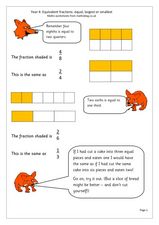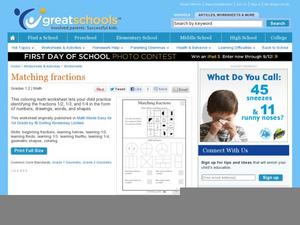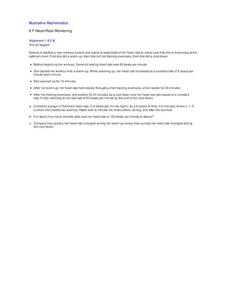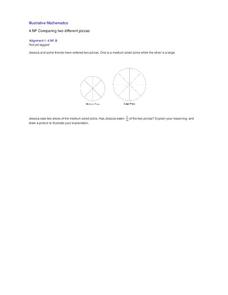Maths Blog
Equivalent Fractions: Equal, Largest, or Smallest
Elementary mathematicians begin by reading a one-page text that explains how to compare fractions. They solve two problems in which they must circle equal fractions in a set. They then solve four problems where a set of five fractions is...
Curated OER
Drop it or not?
Students explore fractions. For this fraction lesson, students play an interactive game and use manipulatives to practice working with fractions.
J. Paul Getty Trust
Still-Life Painting: Arranging Nature—Lesson 1
Art learners examine still-life arrangement images and respond to a series of prompts. In a whole-class discussion, pupils list elements and qualities that still-life paintings can have. After instructors create an arrangement and model...
Curated OER
Barbie Bungee
Middle and high schoolers collect and analyze their data. In this statistics lesson, pupils analyze graphs for linear regression as they discuss the relationship of the function to the number of rubber bands and the distance of the...
Curated OER
Build a Model Submarine
Learners form lab groups and work together to construct a submarine out of a soda bottle. Next, they observe its action in a tub of water as the inner pressure is changed. It is an engaging experiment. However, links to outside resources...
Curated OER
Mouse Count
How many ways can you arrange ten mice? After listening to the story, Mouse Count by Ellen Stone Walsh, it's the young scholars' turn to figure out how their mice can be organized, with some inside a jar and some out. Using visual and...
Curated OER
Match the Number Sentence!
Matching number sentences to their visual equivalents may seem easy, but there is a trick here to keep your learners thinking about math properties. As they examine the numerical forms of six addition problems, they must utilize the...
Curated OER
Making 10 Packs Worksheet
The soup factory is missing cans in its 10-packs! Scholars take on the challenge as they figure out how many more cans are required to complete these four 10-packs. Encourage them to draw the extra cans for added comprehension. It would...
Curated OER
Adding Animals
Writing equations from images helps young mathematicians grasp addition, especially when they get to look at cute animals as they do it. There are six number sentences here, each illustrated with a set of animals corresponding to...
Curated OER
Subtracting
Help kids visualize subtraction by assigning these sets of objects for them to subtract. They examine an example before completing the seven equations on their own. For each, learners cross out the subtrahend value and count the...
Curated OER
Length
Without using a ruler, learners estimate the relative length of various lines in these three scenarios. The first two are set up as maps, with learners determining the shortest and longest distances from one position to another. The last...
Curated OER
Halves and Fourths
Young mathematicians may not love fractions, but do they love sandwiches? How about cake? Use this visual fractions activity to represent fractions in a relatable way. Scholars start by coloring segmented shapes to indicate halves and...
Curated OER
Fractions of Shapes
Explore fractions visually through segmented shapes. Scholars examine sets of shapes and shade in the given fraction. Each shape is divided into the same number of segments as the denominator of the desired fraction, so beginners aren't...
Curated OER
Matching Fractions
Focus on halves, thirds, and fourths in these visual fraction activities. Scholars begin by examining a grid with various expressions of the three fractions displayed in the grid squares. They color-code the grid to indicate which...
Illustrative Mathematics
Naming the Whole for a Fraction
How many different ways can you represent a whole? In a picture that represents six parts (two of which are shaded), learners are asked to label the parts appropriately to show how three different mathematical interpretations can be...
Illustrative Mathematics
Above and below sea level
Using the real-world example of elevation, above or below sea level, young mathematicians interpret expressions using negative signs, and absolute value. This task provides a good opportunity to discuss the notion of magnitude and...
Illustrative Mathematics
Comparing Temperatures
Which is colder -12 or -18? Temperature is natural real-world application of ordering rational numbers. It's also fun to talk about the lowest recorded temperature on Earth. Take the time to discuss this inquiry with your class.
Carstens Studios
Math Doodles
Discover the joy and excitement of improving your math fluency through four different puzzles. Combine those with 25 different ways to represent numbers and you have hours of enjoyment that can be fun outside of the classroom as well.
Curated OER
Heart Rate Monitoring
Algebra learners like this resource because it is easy to understand and it relates to their lives. Whether you are starting a new workout routine, or just climbing the stairs, your heart rate increases and decreases throughout the day....
Illustrative Mathematics
How Many Servings of Oatmeal?
Here is another way to illustrate division of a whole number by a unit fraction. In this case, the problem is asking if there are so many servings per cup, how many servings are in a package of multiple cups. Learners are to model their...
Illustrative Mathematics
Drinking Juice, Variation 3
It is up to the learner to find the amount of juice originally in a bottle, knowing what fraction of the juice is left, and the amount that has been consumed. The accompanying commentary provides a useful and detailed description of...
Illustrative Mathematics
Comparing Two Different Pizzas
What better way to learn about fractions than with a couple pizzas? Help Jessica figure out how much of the pizza she has eaten, while teaching your class that fractions refer to a specific whole amount. This problem will be challenging...
Illustrative Mathematics
Drinking Juice, Variation 2
An excellent activity using word problems where pupils interpret and compute quotients of fractions. The commentary includes using a fraction bar model and equations to represent the problem. In this variation of the resource, the...
Scholastic
Study Jams! Electricity
Shock your physical science class using this video to teach the basics of static electricity. Electricity is defined,and electrons are differentiated from protons on an atom model. The use of hydropower and wind are explained as ways of...
Other popular searches
- Array Model of Multiplication
- Bohr Model
- Dna Models
- 3d Cell Model
- Bohr Model of the Atom
- Atomic Model
- Model of Atoms
- Circulatory System Model
- Human Arm Model
- Solar System Model
- Equivalent Fractions Models
- Model of Saturn

























